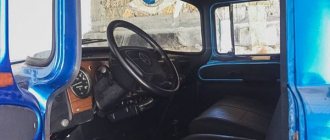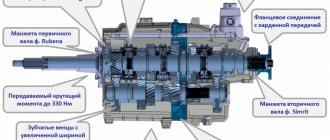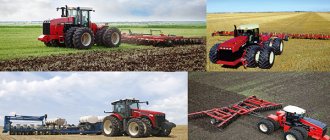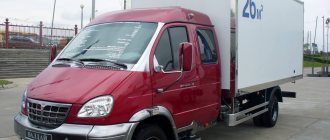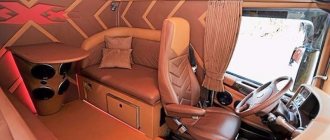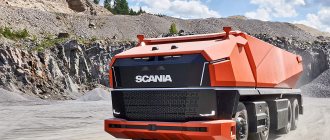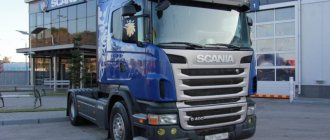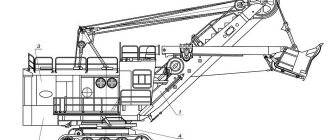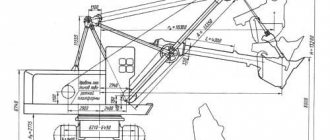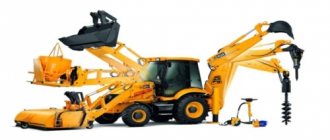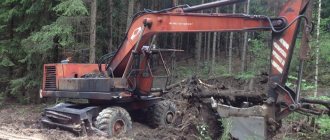How the Scania R730 works
This truck model was created by Swedish specialists taking into account the ability to work in difficult operating conditions.
When designing each working unit and system, the maximum possible level of loads was taken into account, which made them especially reliable and durable.
The Scania R730 is characterized by increased strength of the cab frame. This protects it from increased loads and vibrations that occur while driving on particularly uneven sections of the road. It is precisely because of the reliability of the truck that many transport companies choose it, who want to organize the transportation of various goods as efficiently as possible.
Cabin Scania R730
Dump trucks, tractors 6x6 Scania YAKUTIA KHABAROVSK MAGADAN BLAGOVESHCHENSK
Reviews of Scania R730 tractors
Scania R730 tractor test - Scania R730 (2009). Comparison with MAN TGX 680
Scania takes the quality of the interior: the plastic is downright magnificent (no match for that of the new Actros!), the table is very hard, and in addition there are cozy details like night lamps on flexible legs.
If in MAN it is more convenient when parking, then in Scania it is more convenient when driving! The seating position is close to that of a car, and you find a comfortable position very quickly. The low-set mirrors do not interfere with the view, the panel “envelops” the driver... But the MAN is more “traditionally cargo-carrying”: the seating position is not so comfortable, and you have to get used to it; the seat, despite more developed lateral support, is not so cozy.
If without a truck Scania does not drive so confidently on a snowy road, then with it it is noticeably better than MAN! You don’t have to “catch” it with the steering wheel on the road, the car is less prone to skidding...
The difference is in the steering and suspension: Scania's steering is more accurate, but the steering wheel gets jolts from small irregularities. But MAN “swallows” them, but “eats” large potholes worse. And if the Scania’s steering wheel rim is thin, then the MAN’s is even too thick.
MAN is also noisier. If there is silence in Scania (except that the instrument panel creaks on bumps), then the MAN engine does not even whistle while driving, but howls, especially during gear changes.
Of course, both “automatic machines” operate imperceptibly, without even a hint of jolts when switching: the designers taught this to the electronics. But with MAN she strives to keep the tachometer needle below the “green zone” all the time and switch to a more economical, higher gear. This in itself is good, but on a snowy slope the car may lose speed and eventually stall!
In addition, the system switches gears up and down every now and then, looking for the most suitable one. I counted: on a snow-covered turning circle with a diameter of about fifty meters, the Manov gearbox “clicked” the steps eight (I repeat, eight!) times.
“The eighth - the seventh - oh, no, the eighth again, sorry, I was wrong, after all, the seventh, no, the ninth...” What are you talking about, dear? As a result, all the way we had to manually “push” the gears with the steering column lever (fortunately the system allows this), and on a long four-percent climb we had to completely switch to manual mode in order to “lock” the selected gear. Otherwise, in the middle of an ascent, the gearbox will easily switch to a higher gear and “land” the road train!
But Scanie’s “automatic” Opticruise is much more competent and intelligent. It’s as if he sees the road and knows what you need: he switches as rarely as possible and exactly at the speed required in a given situation, requiring almost no manual intervention. On the same lap, Opticruise changed gears only three times (twice down and when exiting the lap up), and on a long climb it not only allowed it to gain momentum, but also allowed it to accelerate the tractor. As a result, where on MAN I could hardly crawl up a hill at 50 km/h, Scania easily accelerated to 65 km/h!
And here's another thing. When, while driving a MAN in automatic mode, you “push” the gear manually, the system shows on the display that it has temporarily switched to manual mode. But if at this time you try to turn this manual mode “on permanently”, the box... goes into automatic mode again.
But with Scania everything is clear: if you drive in automatic mode, it is turned on even during manual manipulations with the gearbox. And as soon as you press the button on the end of the lever, “M” lights up on the display, manual, that is, manual mode.
Here it is, the difference between a purchased gearbox (let me remind you that MAN has ZF AS-Tronic) and a self-developed one! So the future lies with systems like Scania’s: with a slope sensor (that’s why the box “sees” the profile of the road) and “learning” (the system adapts to the driving style).
Fedor Lapshin
while moving, the MAN has to be held, and very tightly, like a horse that should not be allowed to feel the slack - especially on uneven surfaces. But Scania doesn’t just allow me to relax: it seems to guess my intentions! Before turning, you slightly release the gas, and the smart automatic transmission carefully slows down the car. The Scania cabin is also much quieter, and it has better visibility - unlike the MAN, where the A-pillars and huge mirrors get in the way.
Natalia Shevtsova, administrator of Autoreview
A MAN with a semi-trailer stands worse on the road - it is possible that it is due to different tires. In addition, Manov’s “automatic machine” was constantly trying to convince me that he was smarter, and I constantly had to correct him by “tucking” the gears. Click-click, click-click... I'm already tormented!
Not only was I struggling with the winter road here, but I was also struggling with the car: I practiced all the time, “oiling” the steering wheel and pulling it out of a skid. Now I understand why, in this weather, truck drivers in such “foreigners” can barely plod along: I’m in my Merc with a manual transmission, and I shift and go faster! And if I drive at the pace that MAN imposes on me, which customer will order me?
But Scania drives a semi-trailer much more confidently and engages gears the way I would engage them myself: it seems to understand me! It’s not surprising that when I was second in Scania, I was always “breathing down” MAN’s back, and when I was first, I “ran away” from him.
It’s also more comfortable for me to sit in Scania. Dmitry Silin, private truck driver, drives a Mercedes-Benz SK1838
Scania has a more pronounced mutual understanding between the car and the driver. Thanks to the “smart” gearbox, the tractor better understands what I want from it! Apparently, its automatic transmission is tuned specifically for this engine - and allows it to operate in a wide range of revolutions without having to change gears again (although in problem areas I still switched to manual control of the transmission - it’s more reliable). And the sound insulation of the Scania engine is clearly better.
powerful engines are good, say, when transporting heavy loads in mountainous areas, and overtaking with them can be completed quickly and safely.
Nikolay Panov, international truck driver, drives a DAF CF85
"Autoreview" 2012, No. 1
- Detailed information about the Scania R730 tractor
- Test of the Scania R730 6×4 road train
Basic operating parameters of the vehicle
The main technical characteristics of the Scania R730 include:
| Curb weight of the vehicle | 7800 kg |
| Weight of the truck as part of a road train | 40 t |
| Wheel formula of the tractor | 6x4 |
| Maximum possible speed | 200 km/h |
| Load capacity | 220 t |
| Wheelbase | 4.1 m |
| Power | 730 l. With. |
| Torque | 3500 Nm |
| Engine capacity | 16.4 l |
| Fuel tank volume | 500 l |
Truck tractor Scania R730 4x4, 6x4, 8x6, 8x8, 10x4
The Scania R730 truck tractor is ideal for both long-haul transportation and construction work
Scania R730 V8 in configurations : 4x4, 6x4, 8x6, 8x8, and even 10x4.
Wide range of frame choices : both for platforms with cars, tanks with liquid petroleum products and bulk goods, platforms with containers, and vans with general goods.
Scania is currently testing new engines running on compressed and liquefied gases (CNG and LNG).
Scania R730 V8 with 13 axles and was able to demonstrate a record payload of 105 tons.
Scania R730 – High power included
There is only one truck manufacturer that offers V8 engines in its Euro 6 product line - Scania. Moreover, we offer not one, but four different V8 configurations: 520, 580, 580 hp. With. on biodiesel and the most powerful - 730 hp. With. Superior performance in every way has always been and remains an attribute of the legendary Scania V8, symbolizing unrivaled engine performance, dignity and style anywhere and anytime. Scania V8 is designed for those who demand and expect more from our technology. For those who have chosen to transport heavy loads off-road as their business. For those who cannot and do not want to compromise on operating efficiency, power or style. If we are talking about you, then you have come to the right address.
Strength and Balance
Difficult terrain. severe operating conditions. This is where there are no alternatives to the exceptional technical parameters of the V8. With it, any, even the most difficult, transport task becomes manageable - the same applies to quality. The design, which is impressive in its reliability, is the key to long-term trouble-free operation and useful use. The fruits of 40 years of painstaking work by V8 engineers, these engines come to you, but don't go away - they last forever. Owners also report impressive fuel savings from operations using Scania V8 engines. Depending on the load, road conditions and driving style, a V8 can certainly be the choice. Combining incredible power and reliability, the Scania V8 provides an excellent total cost of ownership. And by choosing the biodiesel option, you will thereby reduce CO2 emissions.
R730 engine range
With our range of Scania V8 Euro 6 engines (730 PS, 580 PS, 520 PS) , we offer the power that can open up the biggest opportunities for your business. The torque curve is carefully coordinated with the power curve, which allows you to overcome any inclines with ease and without loss and go at average speed at low speeds. We will help you choose the engine that is ideal for your tasks.
Scania V8 engines are also available in other environmentally friendly versions. On the Russian market, V8 engines are offered with Euro 4 and Euro 5 environmental standards with a capacity of 500 hp. pp., 560 l. With. and 620 l. With. and Euro 5 with power of 500 hp, 560 hp, 620 hp. and 730 hp
Lasting impressions
Scania V8 is a truck for those who demand more. Owning a Scania V8 therefore becomes an open statement that speaks for itself. a statement of your ambition, reflected like a mirror in the exclusive styling of the V8. Both the exterior and interior of the cabin offer a range of features and options to customize the V8 style.
- Scania lettering in chrome.
- Chrome plated air intakes.
- Black Brilliant style radiator with unique grille pattern.
- Chrome emblem.
- Chrome V8 emblem.
- The lower contours of the cabin are in the same color scheme.
- Chrome trim on the aerodynamic fairings of the cabin.
- V8 emblem on the side skirts.
- Special exhaust pipe design.
- Xenon headlights with special black bezels.
Cabin interior : V8 symbols on the instrument panel, V8 symbol on the center instrument panel, V8 logo on the door sill trims, metal pedals with rubber pads, V8 symbol on the remote control.
Cabin Options Package : Black wood-grain steering wheel with leather wrap, Black ribbed leather seats with V8 embossing, Black leather armrest, Ribbed leather floor mat, Black griffin door panels, Badge V8 on the door.
You can get more detailed information about the technical characteristics, equipment, prices, terms of sale of cars, as well as the purchase of a Scania R730 tractor by contacting the managers of our company.
Engine Scania R730
The truck is equipped with an eight-cylinder V-type engine. The power characteristics of the engine allow the vehicle to move without difficulty even on a large slope.
This engine model differs significantly from previous ones by reducing harmful emissions into the atmosphere (by 90%), which makes it environmentally friendly. The amount of nitrogen oxide and hydrocarbons released decreased by 40%.
The main advantage of the Scania R730 engine is its repairability and ease of maintenance. All parts of the truck are unified, making them easy to replace.
Transmission
The truck is equipped with an automatic transmission. This system has an excellent cooling mechanism, which ensures uninterrupted operation in any conditions. The gearbox operates together with the speed controller, which ensures smooth movement of the vehicle.
The excellent gearbox design provides the Scania R730 with 12 different operating modes. There are also two reverse speeds. The clutch pedal is used to start and sometimes to brake.
Brake system
ABS braking system - operating diagram
The Scania R730 tractor unit is equipped with EBS and ABS braking systems as standard. This mechanism also includes a disk device. To increase safety during operation of the truck, it is equipped with a system that prevents it from rolling away.
This mechanism is adjusted from the instrument panel using a special switch. If activated, the vehicle will begin to move only after pressing the gas pedal.
Thanks to this design of the brake system, the Scania R730 has a long service life and wear resistance. If the truck is moving on a slope, the locking mechanism can be forced to be activated or everything will happen automatically.
First test drive of the new generation Scania S730 – MAXTRUCKER
What do you need to know about the new generation of Scania long-haul trucks?
New cabin.
This is not just a new tail on an old frame - this is truly a new cockpit. At the moment, there are two versions, as the Scanians themselves call them: 20-inch and 17-inch cabins - both cabins with sleeping places, but the first, as you guessed correctly, is larger and has a sliding sleeping shelf almost 1 meter wide.
Three roof height options. The top cabin is called “S-series”, it has a flat floor and an internal height of 207 cm. The space is unreal, reaching the passenger is a problem.
All cars are finished with high-quality soft plastic and sound and vibration insulation, unlike some competitors, is all very good.
Naturally, there are countless configurations - from the simplest with a plastic steering wheel and cloth seats, to the most expensive, completely trimmed in leather, equipped with coffee makers, microwaves, TVs, refrigerators, etc. and so on. etc. Plus, a long list of options.
New engines.
Under the cabin, new engines are a 13-liter inline six and a 16-liter V8 (the only one in the world that meets Euro 6 standards).
The new engines have abandoned exhaust gas recirculation (EGR) systems and achieve Euro 6 standards only by injecting synthetic urea AdBlue into the exhaust tract (SCR technology).
In order to achieve this, we had to raise the compression ratio to 20.1:1! This is a lot for a heavy turbodiesel truck. The combustion chamber has been optimized. They abandoned the variable geometry turbine. We completely modernized the air intermediate cooling system (intercooler) and increased the radiator area. The engine operates in a fairly harsh mode and the developers promise that this will save up to 3% of fuel.
Transmission.
They did not change the proprietary Scanian automated transmission OptiCruise - it is already the best in the class. No wonder, since 2018, MAN has been abandoning its own transmissions and will be equipped with OptiCruise.
I really liked the modernized retarder; it is a whole system that uses both the service brakes and the transmission at different stages. Well, as is customary on Scania, as soon as the retarder is turned on, the fuel supply is completely cut off.
Chassis.
The chassis was reconfigured: the tank with synthetic urea was moved under the frame, the brake receivers were hidden between the side members, and the batteries were placed in the rear overhang.
Bridges
The drive axles also remained the same, the only innovation is the ability to order a main pair with a gear ratio of 2.35:1, but such vehicles are not relevant for Russia - this is an economical main pair for good European roads, where long-haul trucks can be used on 18-inch wheels and The routes run along the plain.
Summary
The car turned out to be successful, comfort, economic and environmental indicators are excellent - everything is great. However, no one is yet able to say how much such beauty costs because in Russia these cars will appear with Euro-5 engines and not earlier than in a year, at best in the fall of 2017, and in fact from the beginning of 2018.
maxtrucker.ru
Steering
To control the truck, the cab has a convenient and comfortable steering wheel for the driver. This is possible due to the fact that it is covered with anti-slip material. The engine tunnel is partially located in the cabin, but this does not interfere with the driver and passenger.
There is a lever on the steering column that activates the mechanical connection. In the same area there are buttons with which you can control the speed controller, set the temperature in the cabin, and turn on the radio.
Cabin description
The Scania R730 tractor is equipped with a high driver's cabin of the TopLine modification. Its design provides the highest comfort and level of operator safety, convenient placement of all main control mechanisms.
To get into the interior of the truck, you need to climb steps that are placed with some offset. The cabin design is quite attractive, which is achieved by using particularly high-quality materials. The seats for the driver and passenger and the control panel are decorated with leather inserts.
Characteristics of the Scania R730 cab and other truck models
The height of the cabin is 2.23 m, so it is comfortable for people to be there. The advantages of the Scania R730 tractor include the ability to install a coffee maker, refrigerator, microwave oven and other household appliances.
There is a table in the glove compartment in front of the passenger seat. In terms of convenience and design, it is no different from the driver's one. The chairs can be adjusted in height and tilt. It is possible to change the position of the steering wheel, which is also very convenient. You can adjust the distance between the driver's seat and the front panel. It varies in the range of 0.23–0.63 m.
The tractor cabin has many niches and shelves where you can store personal items. There is a hook for a garbage bag.
Related video: Scania R730
Publications on the topic
Description of the Scania P380 dump truck
Technical characteristics and general description of the GAZ-33104 Valdai truck
General description and technical characteristics of the Scania P400 dump truck
Scania S730
The French presentation of Scania that took place a little earlier, at which the new generation of long-haul tractors were presented, was bright and exciting in everything, except for one thing - no one managed to get behind the wheel then.
But we came to Sweden, to Södertälje, with a specific and foreseeable goal: to conduct a full-scale test on roads of varying quality and on fully loaded road trains. The new generation of Scania has been awaited for more than 20 years. The previous, fourth, series appeared in 1995 and experienced two restylings (in 2005 and 2013). Logically, the new Scania should be called the “fifth” generation, but the Swedes themselves avoid this name in every possible way and limit themselves to the term “new generation”.
Before the trip to Sweden, I was sure that only the cabin had been updated - especially since just three years ago a restyled version of the Scania Streamline with the most advanced solutions was shown... However, there were many more changes - this is truly a new car. The 20 billion Swedish crowns (about 2 billion euros) spent on the development of the new generation were not wasted in vain!
Subject of fierce controversy
The new design of Scania does not leave anyone indifferent - there is a wide range of opinions: expected from the assessment of “cool” to “completely sucks” and “ruined the bench”... In fact, such a reaction is predictable - exactly the same opinions were expressed after the premiere of the new generation Mercedes Actros MP4 in 2011, and Volvo FH in 2013... Perhaps the ratings there were even sharper. But several years have passed, and new Mercedes and Volvo have already become familiar. The same will most likely happen with Scania. The fact is that mainline carriers are one of the most conservative groups of buyers; only bus owners are more conservative than them - they generally do not like innovations.
So design is a matter of taste, and although it is interesting, it is not the first thing. The functionality is much more interesting - and there is something to talk about here. Let's start with the fact that the new Scania now sports four-story lighting technology: while the combination of working and fog lights in the bumper and under it has long become familiar, the new generation of trucks now has LED running lights, which is also expected. But further... The narrow triangles under the windshield are not dimensions - these are high beam headlights! The same can be said about the lights in the upper corners of the cabin. In general, even in polar night conditions, the installation of additional “chandeliers” will not be necessary.
The windshield turned out to be just as flat as on its predecessor - and this is good, and in combination with the fact that the driver's seat was moved forward, visibility even improved. Large mirrors eliminate blind spots, and additional mirrors above the passenger door and windshield are now powered, so you can park close to curbs without risking crushing anything.
The appearance is completed by evidence of serious work on aerodynamics: the sidewalls are covered with metal shields.
The chassis was completely reconfigured: the synthetic urea tank was moved under the frame, the brake receivers were hidden between the side members, and the batteries were placed in the rear overhang. Outside the frame, only the exhaust system and two fuel tanks with a maximum volume of 1,500 liters remained. In addition, the wheelbase was increased by 50 mm to improve weight distribution.
Location
To get into the “top” cabin, you need to climb four steps, two of which are blocked by a door. The largest cabin is now called: “S-series”. There is a flat floor and an internal height of 207 cm. The space is unreal, even reaching a passenger is a problem. The Scania “fourth series” had the best seating position and adjustment ranges for the steering wheel and seats - this gave rise to fears that in the new generation the parameters might change to suit the design... But they were in vain - the ranges are huge! You can sit like in a car, with the driver's seat completely lowered to the floor and the steering wheel raised as much as possible - or vice versa. At the same time, the maximum height of the driver that the Skaniya team was counting on was 212 cm!
This is not just another “tail” on the old frame - this is truly a new cabin. At the moment, there are two versions: as the Scanians themselves call them, “20-inch” and “17-inch”. Both are equipped with sleeping places, but the first, as you guessed correctly, is larger, and it can accommodate a sliding sleeping shelf almost 1 meter wide. In addition, there are three roof height options. Later, “day cabs” without a bed will be shown for construction equipment and delivery trucks.
The plastic trim in all cars is soft, and the sound and vibration insulation is impeccable - unlike some competitors, everything here is really very good.
OF COURSE, THE LIST OF OPTIONS IS LONG, AND THERE ARE A LOT OF EXECUTION OPTIONS – FROM THE SIMPLE WITH A PLASTIC STEERING STEERING AND “RAG” SEATS TO THE MOST EXPENSIVE, FULLY TRIM IN LEATHER AND EQUIPPED WITH COFFEE MAKERS, MICROWAVES, TELEVISIONS WORDS, REFRIGERATORS AND CENTERS OF OTHER OPTIONS.
I got the top-end configuration for testing, and it’s easier to say what wasn’t there – there was no coffee maker. Everything else, including the refrigerator and tablet, was there.
The berth is another reason to look into the cabin. It has cutouts for the backs of the driver and passenger seats: the width of the shelf behind the backs is about 55 cm, and in the middle - 75 cm. The length of the sleeping shelf is 215 cm! In the S-series cabin, the seats move forward in one motion, and the berth can be further moved apart by 20 cm. However, you have to put in a lot of effort - the handle you have to pull is too small.
Working space
When you move from your sleeping place behind the wheel, you realize that the “center of the universe” is still right here. In the top-end configuration, the steering wheel itself is trimmed with high-quality leather, very pleasant to the touch. The cross-section and shape can be considered optimal, and the lower segment of the steering wheel is cut off - not in a sporty way, but rather, taking into account beer lovers with voluminous bellies.
On the steering wheel, of course, there are control buttons for the media center, on-board computer, hands-free system and active cruise control. The instruments, which retain the same location as in the Streamline version, are still clearly legible in any lighting - this, however, is a formal remark.
But the right steering column switch is somewhat overloaded: it contains control functions for the automated Opticruise gearbox with the ability to switch in manual mode, plus control of the retarder and two-stage engine brake - you will have to get used to this.
But the handbrake turned out to be familiar and sticks out on the front panel. The developers assured us that a “button” will soon appear - the same as that of competitors. But for now, according to the chief designer, “customers are conservative people, and they wanted to see a normal handbrake handle on the front panel.”
The front panel itself, according to the Scanie tradition, is turned towards the driver, and in order to use secondary functions, you do not have to lift your back from the seat. And there are many of these functions. In addition to navigation with three-dimensional European maps and a good radio, the multimedia complex is equipped with a two-channel Bluetooth system - now the driver can connect not only a business phone, but also a personal phone to the hands-free system. And in order to charge it, there are as many as three sockets with USB connectors on the front panel, plus one more on the rear wall of the cabin. In general, there will be no discharged gadgets in the cabin. Under the media center there is a climate control panel and transmission control buttons. In general, there are quite a few buttons - but still fewer than those of competitors.
AND HERE WE GO TO THE MOST INTERESTING THING. THE CONTROL REMOTE FOR MIRRORS, WINDOWS AND LIGHTS IS LOCATED ON... THE LEFT WINDOW SILL! YES, YES, EXACTLY ON THE DRIVERS DOOR. IT IS PRETTY CONVENIENT TO USE ALL OF THIS, BUT... WHAT HAPPENS IF THE BUTTONS AND JOYSTICKS ARE FLOODED WITH WATER?
How will the wire loop behave in the driver's door? We asked these questions to designers and engineers - their answer can be translated approximately as follows: “all these functions have been subjected to multiple tests, both mechanical (opening and closing doors, pouring water) and thermal (cooling and heating), and everything should work as normal okay”... In my opinion, the decision is more than ambiguous.
Driving force
Under the new cabin are new engines: a 13-liter inline six, the maximum power of which was increased to 500 hp. s., and torque up to 2,200 Nm, and a 16-liter V8 (the only one in the world that meets Euro 6 standards), covering a power range of 520–730 hp. With. The new engines have abandoned the exhaust gas recirculation (EGR) system and achieve Euro 6 standards only by injecting synthetic urea AdBlue into the exhaust tract (SCR technology).
Test drives / Singles
Elon Musk's nightmare: test drive Scania G340 on methane
Technical educational program Having titled the article this way, I am, of course, prepared for a wild outburst of emotions in the comments to this material, with accusations of technical illiteracy, amazing short-sightedness and...
62220701.06.2016
To achieve this, a lot of work had to be done. The compression ratio was raised to 20.1:1 - this is a lot for a heavy-duty turbodiesel truck! In addition, engineers optimized the combustion chambers, abandoned the variable geometry turbine, completely modernized the intercooler system and increased the radiator area. The engine operates in a fairly harsh mode, but the developers promise that this will save up to 3% of fuel.
the OptiCruise automated transmission was not changed - it is already the best in the class. It’s not for nothing that MAN is abandoning its own transmissions from 2022, and OptiCruise will be installed on their trucks.
The drive axles also remain the same, the only innovation is the ability to order the main pair with a gear ratio of 2.35:1. But such vehicles are irrelevant for Russia - they are an economical main pair for good European roads, where long-haul trucks on 18-inch wheels can be used, and the routes run along the plain. One last passing note about the technology: the service brakes are, of course, discs on all axles.
Movement into life
The fact that at the first world presentation customers were not allowed to drive is a big omission of the marketing department: the new Scania reveals itself precisely in motion. Only in motion can one appreciate the excellent noise and vibration insulation, the correct operation of the automated transmission, and the maneuverability of the new long-haul tractor.
Scania S730 engines
13 l, 500 hp / 16 l, 520-730 hp
It so happened that the first truck I drove along the highway turned out to be a super-heavy (64 tons) and super-long (24 m) “Scandinavian” road train - such vehicles can go on the roads of Sweden, Norway, Denmark and Finland, and in the rest of the world they are operation is prohibited. But we are in Sweden, and since there was a chance, it would be a sin to miss it.
The first thing I would like to note is a very unusual sensation: you have to drive “by the mirrors.” But do you know what amazes the most? The fact that the entire coupling behaves monolithically, and there are no usual twitches reminding the driver that a rather large tail is trailing behind the car. And the second thing is that the Swedes were able to calculate the kinematics of the trailer in such a way that all its five axles exactly follow the track of the lead vehicle! It is fantastic. And yes, the 730 hp V8 engine (3,500 Nm) from Scania does not feel this heaviness! Later, I specifically checked my impressions on a regular 16-meter Euro truck: yes, the dynamics drop a little, and on a descent the retarder can be used not fully, but a couple of steps less - but in general the car behaves predictably, and 64 tons of total mass is simply not are felt.
I really liked the modernized retarder. This is a whole system that uses the service brakes, the transmission (actually, the retarder itself), and the engine brake at different stages. The service braking system is engaged early on to prevent trailer jacking on slippery slopes - and then braking is handled entirely by the transmission. On an 8% descent, the 64-ton road train confidently maintains the set speed, and the service brakes only have to be used to stop completely.
WELL, AS IS PRACTICAL ON SCANIA, AS SOON AS THE RETARDER IS TURNED ON, THE FUEL SUPPLY IS COMPLETELY CUT OFF. THIS IS A REAL SAVING OF BOTH FUEL AND BRAKE PADS.
The simple, human driving experience is the most positive - sound insulation and suspension performance are excellent. The car simply floats both over the asphalt road and over the cobblestones of the “Brussels pavement”. In any driving mode, you can talk in the cabin without raising your voice - few passenger cars can provide such a level of comfort.
Summary
The car turned out to be successful, comfort, economic and environmental indicators are excellent - in general, everything is great. However, no one can yet say how much such beauty costs, because in Russia these cars will appear with Euro-5 engines and not earlier than in a year. At best, in the fall of 2017, and, most likely, from the beginning of 2022.
IN SWEDEN THE PRICE FOR THE TOP SCANIA S730 IS LOCATED AT 150 THOUSAND EUROS. EXPENSIVE? BUT SCANIA HAS NEVER BEEN CHEAP – IT IS A REAL PREMIUM. AND IT'S WORTH THE MONEY. AND I AM NOT ALONE THINKING SO: THOSE CARRIERS WITH WHOM WE MANAGED TO COMMUNICATE ARE READY TO ORDER THIS CAR NOW.
wwwscaniaru.mirtesen.ru
